|
EDWARD,
ARTHUR AND PETER
A
trip to the "Ting Yuen" and the
Pre-Dreadnought
Battlefields of the Yellow Sea
by
Peter
Hunt
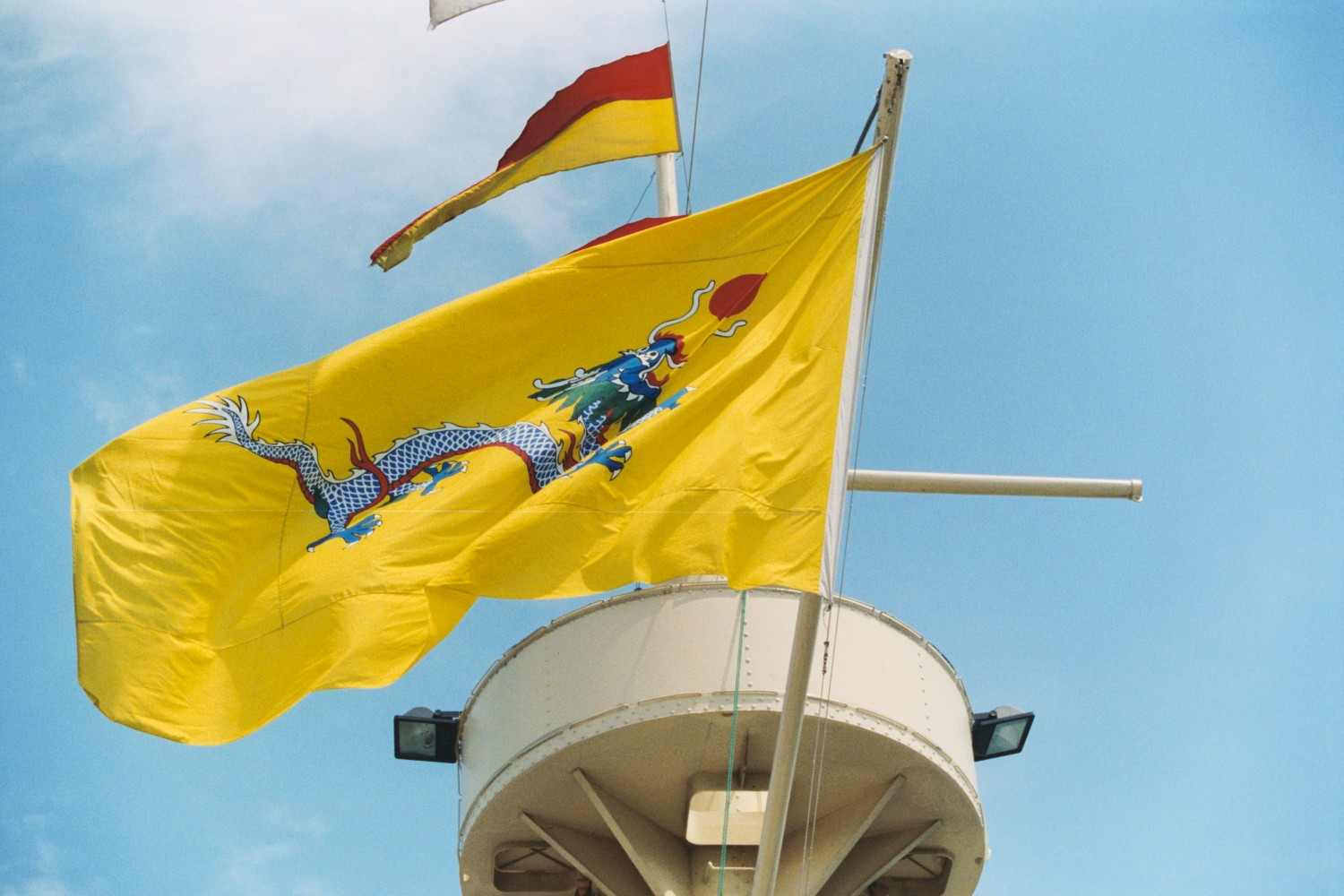 |
|
The ensign of the
Imperial Chinese Navy flies over its newest battleship. |
These
days you do not get many chances to tread the decks of a brand new
pre-dreadnought battleship. Especially
one that was sunk 110 years ago. Chances
to see mighty Krupp guns standing guard over craggy cliffs defending naval
bases, just as they did in 1890, are almost as scarce.
But you do not need a time machine to do these things, just tickets
to Wei Hai (formerly Port Edward), and to Lushan (formerly
Port Arthur), which are situated on opposite sides of the Yellow Sea in
North China
.
There
are a few preserved pre-dreadnoughts and ironclads out there but not many.
So the good people of Wei Hai’s idea of building a 1:1 scale
replica of the Ting Yuen, the flagship of the Chinese Beiyang, or Northern,
Fleet during the Sino-Japanese War of 1894-95, struck me as a feat of
imagination that was well worth supporting with my tourist dollar.
All the more so since the trip can easily be combined with visits to
the Sino-Japanese and Russo-Japanese battle sites at Wei Hai and Lushan.
Getting
There
Wei
Hai can be reached by air or train from
Beijing; or by car from Jinan
(six hours) or Qingdao
(three hours) both of which have flights from
Hong Kong. Lushan is less than an
hour’s drive from Dalien which has good international and internal flight
connections. There is also a
ferry between Wei Hai and Dalien.
|
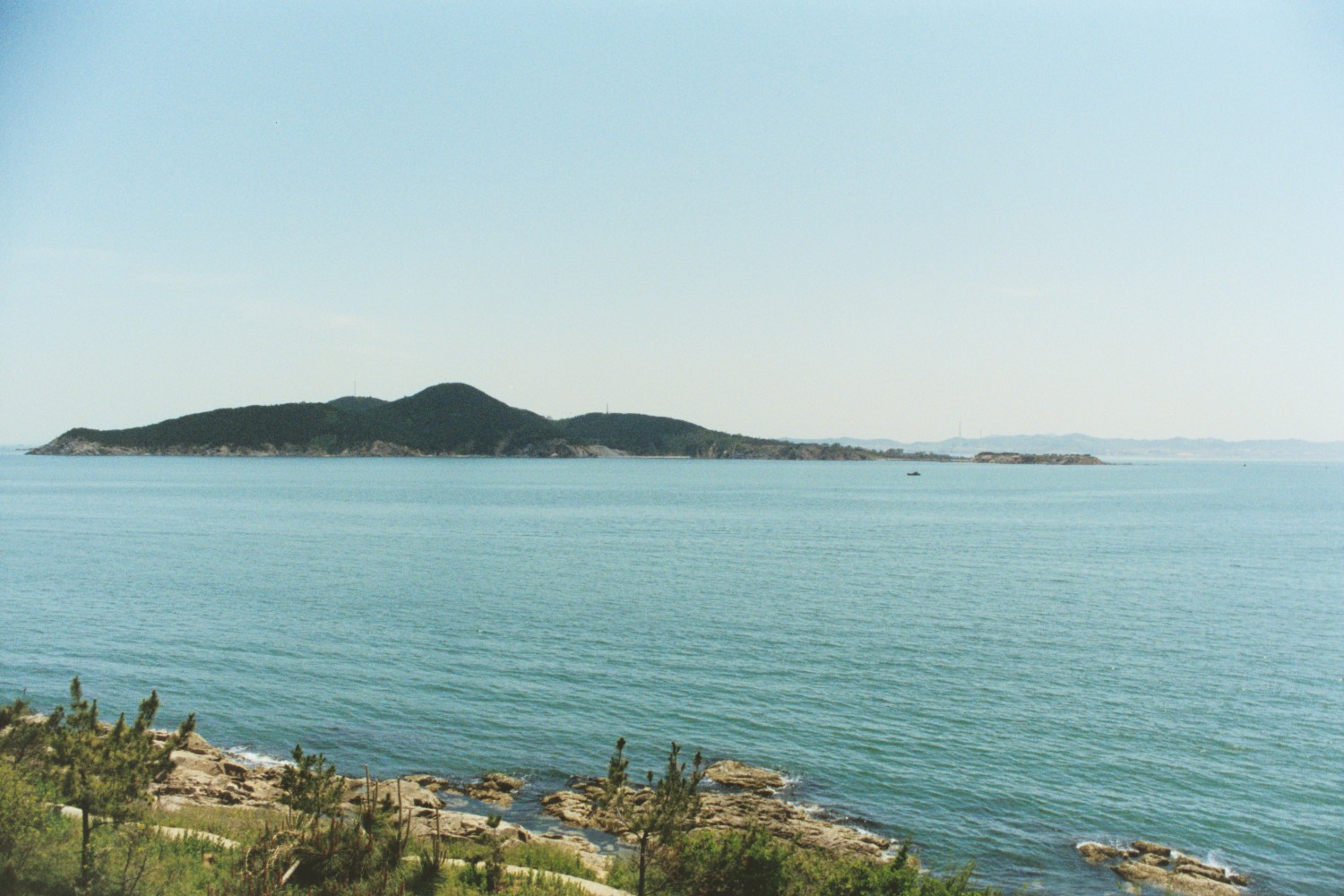 |
|
The western entrance to
Wei Hai Wei ~ Liu Kung Dao as seen from the He Qian Hotel |
In
Wei Hai I commend the He Qian Hotel to you.
It has nice rooms, good food and excellent service, but, for the
pre-dreadnought buff, its location, at the end of the promontory that makes
up the land side of the deep water entrance to the bay, right on top of what
used to be the base’s main defence fort is another key selling point.
Nothing today remains of the six 24 cm and two 21 cm Krupps guns that
were here, except for the grassed terraces on which they stood, but the
views are fantastic. Dalien has
lots of nice hotels. We stayed
in the Swissotel which has good views of the harbour that you can pour over
with your maps of 1904.
A Bit of Background
The
hero of this piece is Admiral Ting Ju-chang, the commander of the Beiyang
fleet. He was not a great Admiral, but then, since he was a cavalry officer
this is understandable. He was, however, brave, honest, loyal and
dependable. In short he was a gentleman. It is China’s tragedy that he had to take his orders from, the villain of this piece,
the Empress Dowager Tz’u-hsi. After
China’s humiliation in the Second Opium War a Sea Defence Fund had been
instituted, using customs revenues to build a modern battlefleet.
The Ting Yuen and her sister represent the best use of this fund.
By
the end of the 1880s
China
had the largest, best equipped, and one of the best trained fleets in
Asia. Unfortunately during the 1890s Tz’u-hsi dipped into the fund for her own
personal use, most notably to rebuild the
Summer
Palace, to include a concrete paddle steamer. Estimates of her peculation vary,
but it was in the range of 10 to 21 million Taels, enough to buy three to
seven of the best battleships in the world. Unfortunately the Ting Yuens
were the first, and only, battleships that China
bought. By that time that war came with Japan
in 1894 the Empress Dowager had a very nice palace, but her battlefleet was
short on pay, ammunition and sea-time. To make matters worse Tz’u-hsi
exhibited the same sort of strategic direction in the Sino-Japanese War that
she did in the later, equally disastrous Boxer Rebellion. Completely out of
touch in the Forbidden City, and basing her judgement on information from ill-informed and self-serving
sycophants, she never appreciated the reality, nor the gravity, of the
situation she was in. As a result of this wishful thinking the hapless
Admiral Ting was given totally unrealistic “rules of engagement”.
|
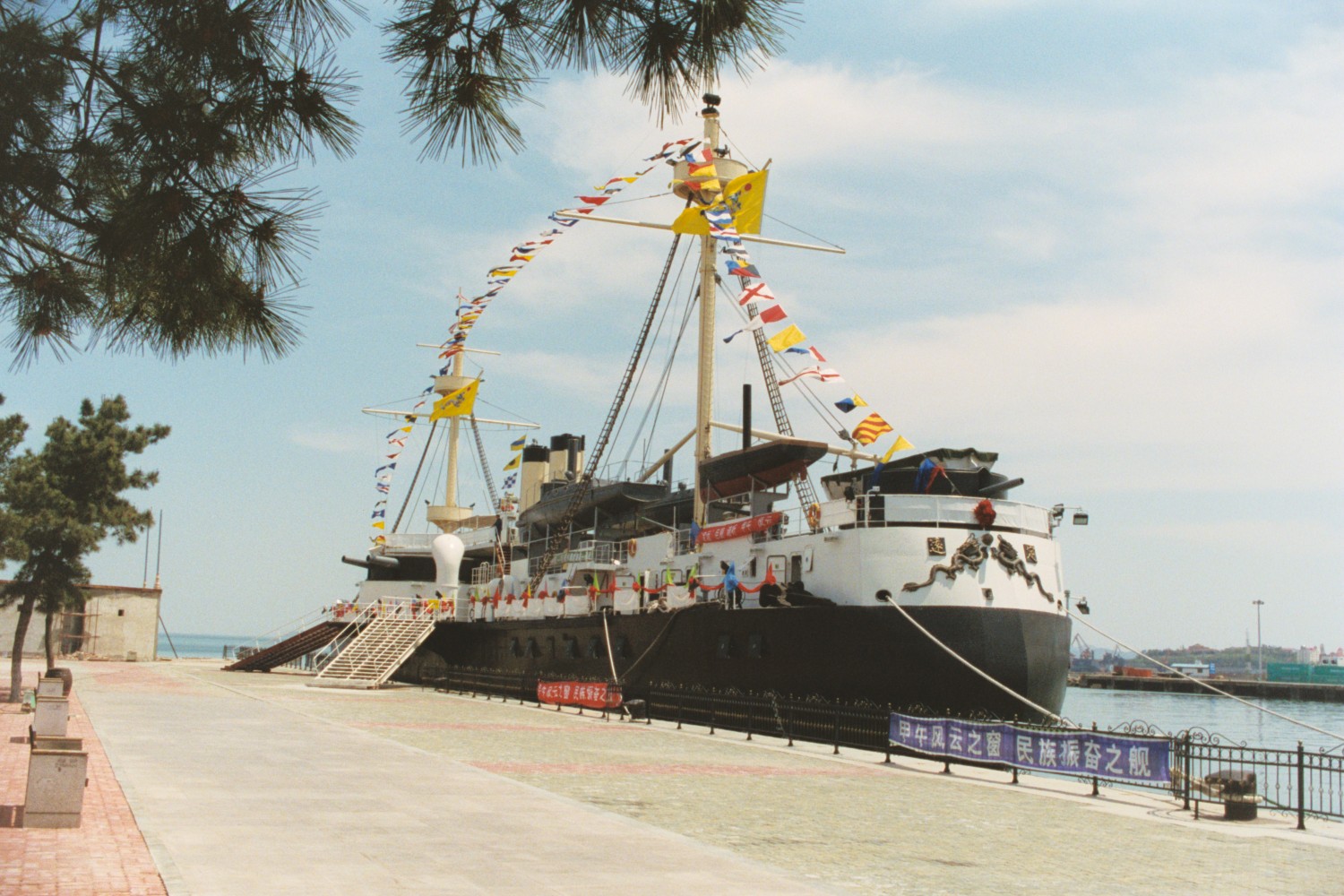 |
|
The Ting Yuen today |
But
first, the ship. When I visited the Mikasa I was
struck by how Nelson might have found that ship from a hundred years after
his day very familiar in places, especially on the long, open tertiary gun
decks where the guns fired through open ports on the broadside.
Neither Nelson from 80 years before, nor a sailor from 120 years
later, would find much to be familiar with in the Ting Yuen.
This is because she is a representative of a short, narrow and soon
extinct branch of battleship evolution that is best described as the central
citadel turret (or barbette) battleship.
The design of these ships came from applying a sort of “Occam’s
Razor” methodology to the problems of dealing with the great improvements
in armour protection and gun penetration that were taking place in the late
1870s and 1880s. The thinking
went something like this:
-
Only
the very heaviest armour was useful, as anything else could be
penetrated.
-
Only
the very heaviest guns were useful, as anything lighter could not
penetrate heavy armour.
-
Because
of the weight there could not be much heavy armour, nor many heavy guns.
-
Therefore
the solution was to concentrate the vitals of the ship ~ her machinery,
magazines and guns ~ in a central citadel which could be heavily
armoured. The rest of the
ship was left unarmoured except for a protective deck at the waterline.
Whether the main guns were in armoured turrets or open barbettes
was a matter of national taste and weight.
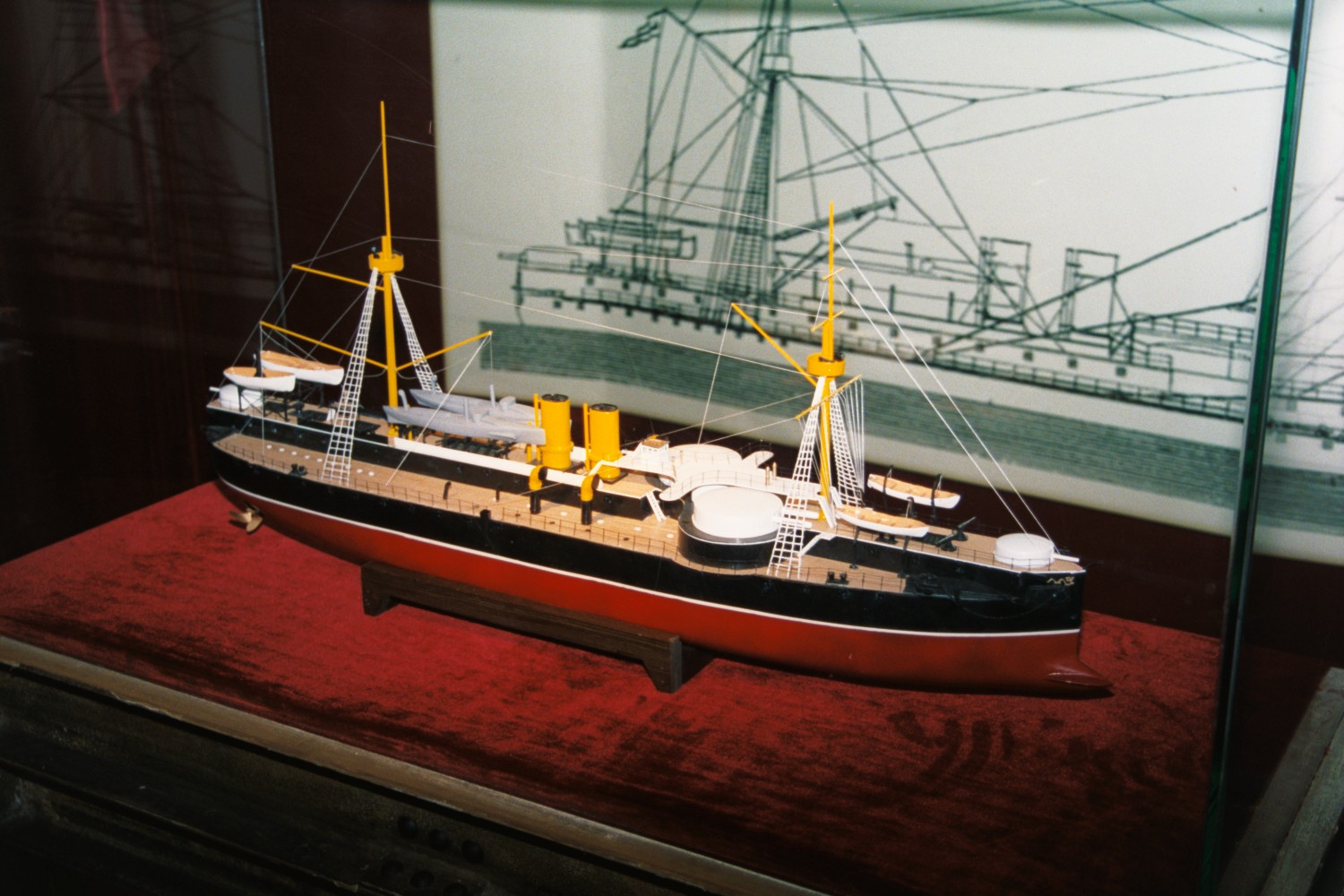 |
|
The model shows the
layout of a central citadel battleship ~ main guns and propulsion
concentrated amidships |
The
Italians were the originators of the design and built three classes for a
total of seven ships. The
British responded with three classes of five ships.
The two early American second-class battleships gave more than a
passing nod to the design theory too, and two were built for Brazil
as well. The fad for these ships
lasted from the late 1870s to the late 1880s, so when Ting Yuen and her
sister Chen Yuen were ordered in 1881 and 1882 they were considered state of
the art vessels at the cutting edge of battleship design.
Ting
Yuen and Chen Yuen were built in the Vulcan Yard at Stettin
Germany, now Szczeczin,
Poland. They displaced 7,670 tons and
their armoured citadel was covered by 14” of compound (steel over iron)
armour. They mounted four 12”
breach loading guns in a barbette amidships, with the guns on two turntables
surmounted by thin, but complete, shields that gave the impression of
turrets. Right forward and aft
were armoured turrets mounting one 5.9” gun each.
They also carried six 37 mm Hotchkiss multiple barrelled guns and
three torpedo tubes. In keeping
with the fashion of the time they also carried two second class torpedo
boats each, to provide for attack and defence, especially at night time.
They could make nearly 16 knots when new.
All-in-all they were very nearly equivalent to the later British
“Edinburgh” class which, for their time, were considered to be first
class battleships, although the Ting Yuens were rather smaller and a bit
slower with shorter calibre main guns. The
Ting Yuens were certainly better ships than their British contemporaries the
Agamemnon class which had only muzzle loading guns.
|
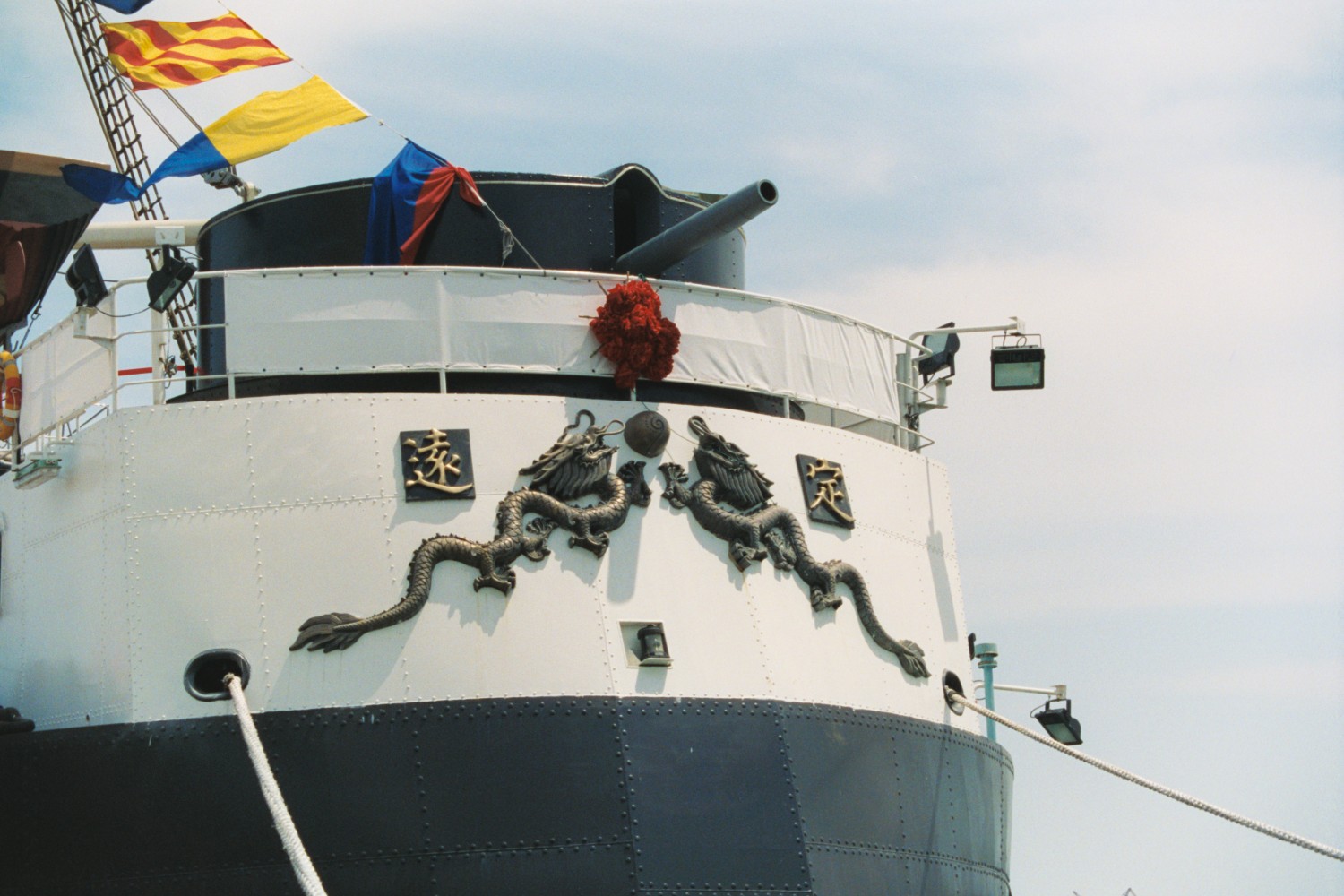 |
|
Ting Yuen's stern and
5.9" turret |
The
central citadel turret battleships were criticized in their day on two
counts. Firstly mounting the two
turrets in the middle of the superstructure, instead of one each end of it
in the conventional manner, severely restricted the arc of fire of the
turrets on their opposite broadsides. The
type’s supporters claimed that since both turrets could fire fore and aft
this would compensate for the lack of wide broadside arcs of fire.
Secondly it was argued that the unarmoured ends of the ships would be
vulnerable to even relatively small guns and shot to pieces in battle,
leading to fire and flooding which would result in the loss of the ships
even if the citadel remained inviolate.
Although the British “Inflexible” fought at the bombardment of Alexandria
and one of the Brazilians was involved in a civil war this was hardly a good
test for the design. However
Ting Yuen and Chen Yuen were in heated action for four hours at the Battle
of the Yalu in September 1894 so they were truly tested.
Their experience there proved the type’s critics right about the
arcs of fire, but wrong about the vulnerable ends.
At
the Yalu the Ting Yuen’s very first shot, fired almost straight ahead,
missed the enemy. But the blast from the gun demolished the flying bridge
upon which Admiral Ting and his British advisor, W. F. Tyler, were standing,
knocking the admiral out for two hours and deafening Tyler
for life . . . obviously the useful arc of fire of the guns was limited!
|
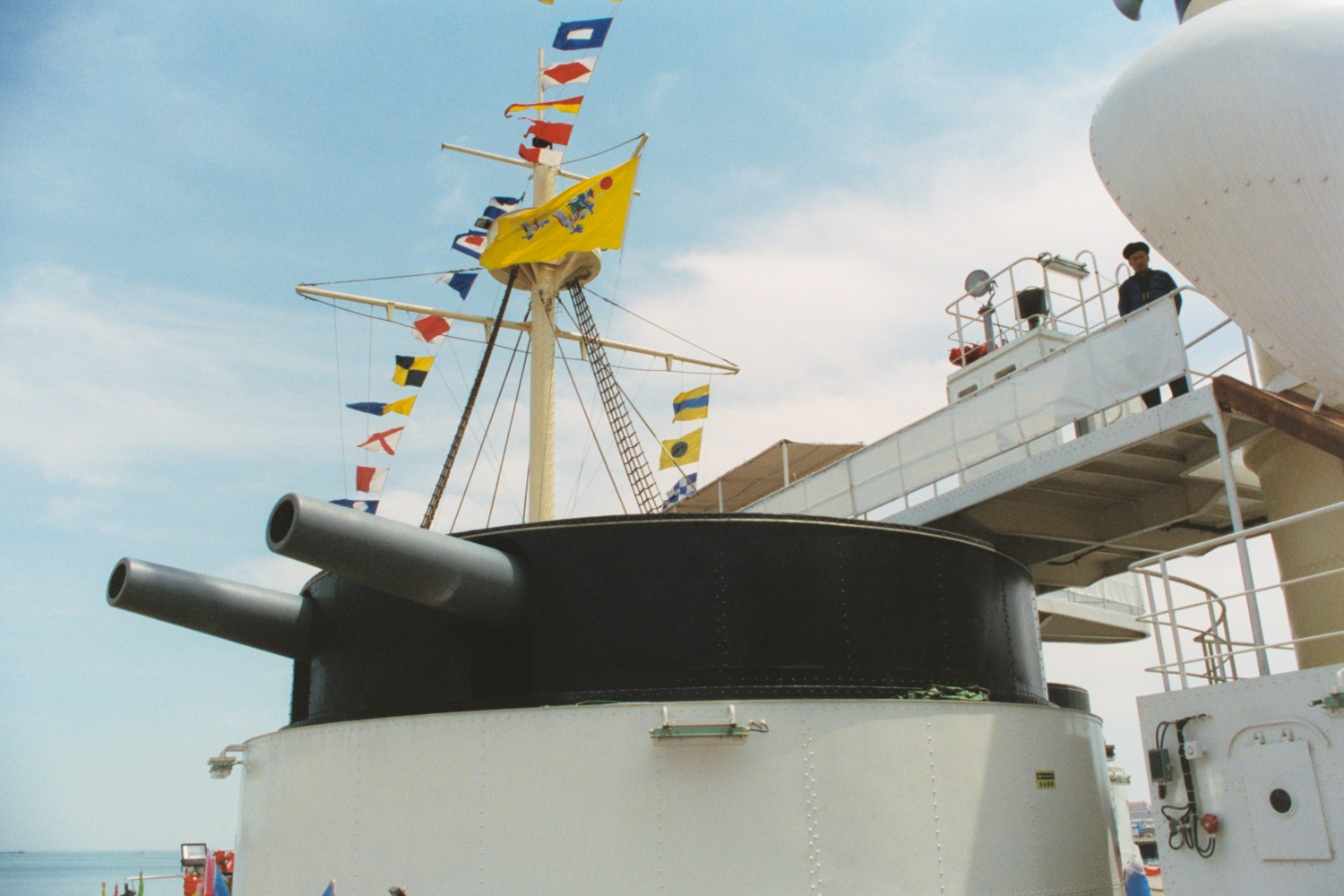 |
|
12" barbette and
the (literally) flying bridge above |
On
the other hand the Ting Yuen was hit 200 times during the battle and Chen
Yuen 150 times, but, although their superstructures were peppered, their
citadels were not penetrated. And whilst they were badly knocked about, they
were not endangered. The Chen
Yuen was shipping some water but the main reason for Admiral Ting’s
withdrawal was because his ships had used up most of their ammunition.
Since it is the aim of a battleship to dish out punishment, rather
than take it, then the design can be considered a success if the ships
survived to dish out all the punishment that their ammunition supply
allowed.
Sadly
for Ting and his sailors the punishment that they dished out was much
reduced because of the pernicious effects of corruption in the Chinese
government and naval suppliers which resulted in much of their ammunition
being old, substandard or even filled with cement rather than bursting
charges. Consequently the Battle
of the Yalu saw five Chinese ships sunk for four Japanese ships crippled.
With better ammunition the balance could easily have swung in China’s favour.
After
repairs at Lushan, and re-ammunitioning (again with sub-standard rounds)
at Tiensien, Admiral Ting moved the Beiyang fleet to Wei Hai.
The ships still constituted a powerful enough “fleet in being” to
constrain Japanese movements. But
then the Chen Yuen ran aground and, although able to fight her guns, became
unseaworthy. Since the two
battleships constituted
China
’s main material superiority over the Japanese the crippling of Chen Yuen
swung the balance of naval power firmly in Japan’s favour.
Even
whilst the Beiyang fleet was still in being the Japanese took a major risk
and despatched an expeditionary force to Lushan.
The base fell to Japanese assault in one day.
The army under General Nogi pierced the defences whilst the Japanese
Navy’s torpedo boats broke into the harbour and supported the land troops
with their small calibre, quick firing guns.
The attack on Lushan was followed by three days of looting and rapine
by the Japanese. Oddly enough
the modern Chinese version of this atrocity stresses the resistance of the
garrison and the civilian population. This
appears to me to be a “reinterpretation” in line with the Maoist theory
of “people’s war”.
It is
clear from contemporary accounts, and the time frame, that the atrocity was
not provoked by a civilian guerrilla campaign but was a Nanjing
style excess where the Japanese army was let out of control and acted in the
most bestial manner.
After
the fall of Lushan the Japanese turned their attention to Wei Hai and
Ting’s fleet. Lushan had been
built up as the main base for the Beiyang fleet, complete with a dry dock
and workshops. Wei Hai was best
described as a protected anchorage. The
bay is protected by the island
of
Liu Kung Dao
on which was located the Beiyang fleet administrative headquarters and coal
stocks. Ten modern forts protected the island and bay from seaward, whilst
six, considerably weaker, positions secured the landward approaches.
The Japanese launched an army to take Wei Hai from the landward side
and the situation turned into a precursor of the 1942 Singapore
debacle. Wei Hai’s main
defences faced seaward and Ting found that instead of the batteries
defending his fleet his ships had to fire to defend the batteries.
When the batteries fell to Japanese attack the fleet had to maintain
the fire to prevent the captured guns being turned against them.
To
keep up the pressure the Japanese launched a series of torpedo boat attacks
into the bay. Some were thwarted
by the freezing winter weather, some by friendly fire, and some by
confusion. But, after six attacks the Ting Yuen and three other ships in the
fleet had been sunk or crippled. Chinese
counter-fire against the Japanese blockaders was hamstrung by their poor
ammunition. Just as at the Yalu,
Japanese ships were hit several times by shells that didn’t explode.
With
the Japanese army and navy tightening it’s grip the days of the Beiyang
fleet were numbered. A sortie by
the fleet’s torpedo boats was quickly mopped up by the Japanese.
Without serviceable ships and with no hope of relief, Ting accepted
the inevitable. On 12th
February 1895 the Beiyang fleet surrendered.
Some commanders turned over their ships intact in the hope of
placating the Japanese and thus averting another atrocity like Lushan.
Others were made of sterner stuff and the Ting Yuen and some other
ships were destroyed by their own crews.
The senior commanders of the Beiyang fleet were mostly honourable
men, and many of them, including Admiral Ting, committed suicide.
The
Ching dynasty was rapidly approaching its nadir.
With the Beiyang fleet destroyed China
was even more open to imperialist exploitation.
Under the peace treaty
Japan
took no territorial rights outside of
Korea
but imposed a swinging indemnity on China
and sought economic dominance. To
thwart the Japanese the Chinese leased the Kwangtung
Peninsula, with Dalien and Lushan to Russia. Acting on the pretext of
protecting missionaries the Germans seized Qingdao. The Russian and German
presence in
North China
was not welcomed by the British, who then leased Wei Hai to keep an eye on
them. The lease conditions specified that the British would leave the town
if the Russians left
Port Arthur.
British
dreams of a Hong Kong on the
Yellow Sea
were still born. The location
and economics were wrong. “Port
Edward” became a base for the British and Chinese navies, a moderately
successful Treaty Port, and a convenient place for the Hong Kong and Shanghai
expatriates to escape the heat of summer.
As if to highlight this recreational aspect, whilst Hong Kong and Singapore
both had cricket pitches in the middle of town, Port Edward went one further
with a full sized golf course as its centrepiece!
The
future of Port Arthur, as Lushan was renamed, was far less pacific.
The Chinese economic and military withdrawal from the North-East
brought
Russia
and Japan
into an almost inevitable conflict. Learning
from the Chinese experience the Russian’s strengthened the defences of Port Arthur
and installed a powerful fleet which the Japanese matched as described in my
article on the Mikasa.
The
Japanese started the 1904 war undeclared with torpedo boat attack on
Port Arthur
followed by naval bombardments. When
the decisive fleet battle did not materialize the Japanese Third Army under
General Nogi, the victor of the 1894 attack, was given the job of reducing
the town.
Whilst
Nogi was in command of both Japanese assaults on Port Arthur, the 1904-5 battle was very different to that of 10 years earlier.
The easy victory of 1894 was not repeated and the siege dragged out
over six months, in what is now regarded as a precursor of the trench
warfare and appalling casualties of World War One.
Unable to reduce the land defences the Japanese made three attempts
to block the narrow harbour entrance by sinking ships in the channel but
this was also ineffective. Eventually
the Japanese seized Hill 203, some three miles from the harbour, and from
this position they could direct 11” coast defence howitzers to drop fire
on the Russian fleet. With the
fleet destroyed and after nearly 60,000 Japanese and 31,000 Russian
casualties
Port
Arthur finally surrendered on 2nd January 1905.
The battle cost Nogi his reputation and his own son.
Only a direct order from the Emperor prevented him from committing
ritual suicide to acknowledge his responsibility.
Nogi lived on with his loss until the Emperor died and then, released
at last from his order, took his own life.
With
the Japanese in possession of
Port Arthur
and the
Korean
Peninsula, and between 1915 and 1922 Qingdao
as well, the
Yellow Sea
became a Japanese lake. Thus Port Edward, rather than being a strategic
balance for the British, became a strategic liability.
Although the lease condition was changed to allow the British to
remain until the Japanese left Port Arthur
the British knew that this was wishful thinking.
Port Edward had outlived its use as a pawn in the Imperialists’
game and in 1930 was amicably returned to China
.
Port Arthur
remained under Japanese
occupation until 1945 when the Russians re-took it and once again
established an ice-free naval base on the
Yellow Sea. As the Cyrillic graffiti on
the various Japanese monuments show, the irony of this turn of events was
not lost on the Soviet soldiers and sailors who remained there until 1954
when Lushan was finally returned to Chinese sovereignty.
The
Ting Yuen Today
The
Ting Yuen had its
“soft” opening on May Day 2005. When
I visited in mid-May the ship had a wonderful, wet paint smell, but the
landside facilities and a few things on the ship were still not finished.
Not to worry ~ in my opinion the 50 RMB, (US$6) admission was a
bargain. The ticket price gets
you an illustrated brochure, and guides (Putongwha only) in Beiyang fleet
ordinary seamen’s uniforms, to show you around and answer questions.
But if, like me, your Putongwha does not extend much further than ordering
beers, you are free to wander at will.
|
|

|
|
One of the guides and a
kotchkiss |
The
upper deck and the officers’ quarters on the main deck have been recreated
in good detail, right down to the rigging, the torpedo boats, the tertiary
armament and the cutlery in the wardroom.
I was interested to note that in addition to the as built armament
given in the standard sources she is shown with two additional 6 lber and
four more 12 lber anti-torpedo boat guns on the weather deck.
Most
of the main deck and the lower deck are given over to exhibition areas.
The former concentrating on the original ship itself and the building
of this replica, and the latter on the Beiyang fleet and the Sino-Japanese
War in general. This includes
models of all the ships on both sides and also a diorama wargames table of
the Battle
of the Yalu with the ships in about 1:300 scale (big beasts!).
This was still under construction when I visited but the ships will
float on real water when it is finished ~ neat or what?
|
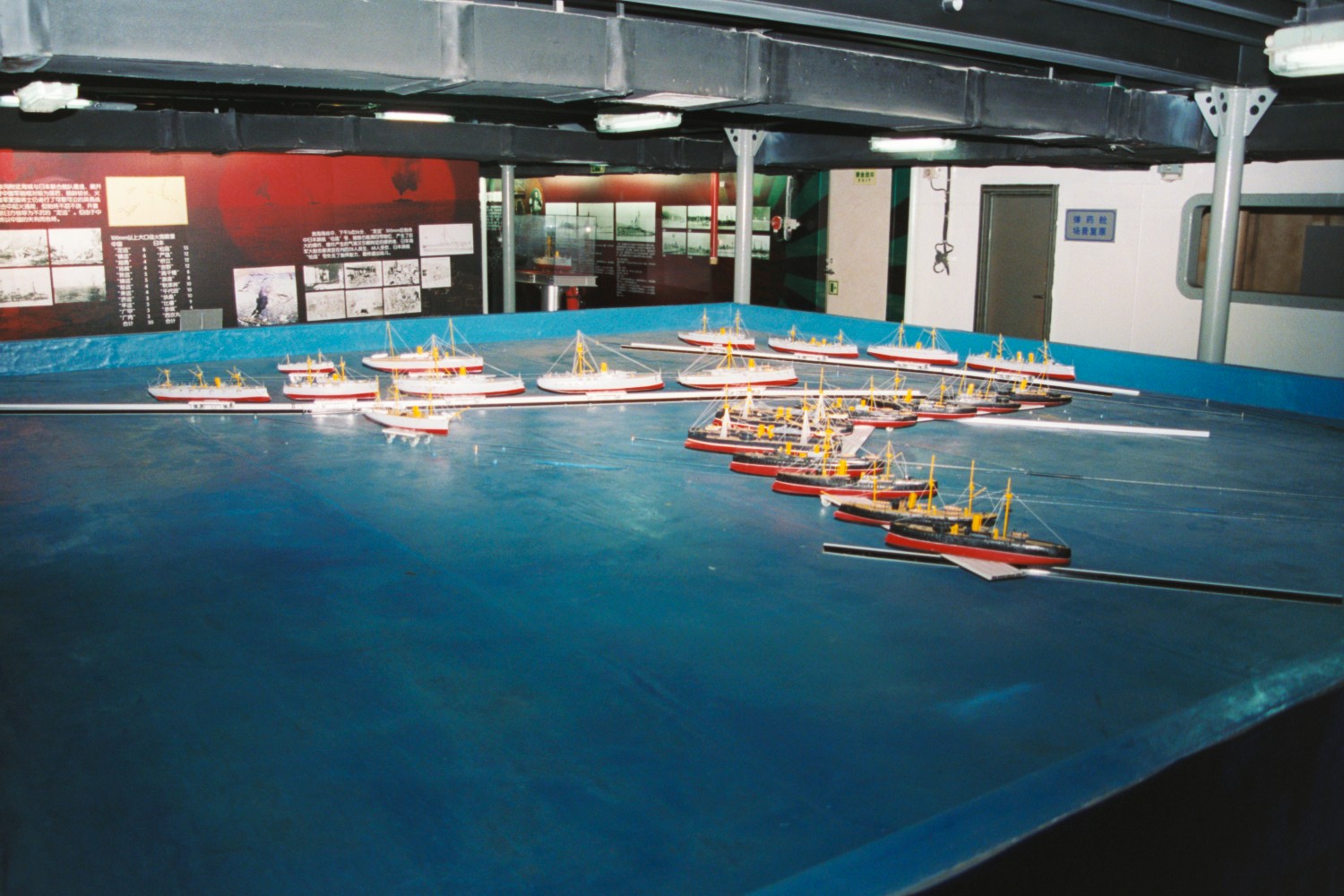 |
|
The,
still dry, wargames table.
The
Chinese ships are inaccurately shown in "Victorian" livery;
in fact, they were in two-tone grey. |
One
touch that I particularly liked is that the side spaces on the museum
floors, which on the original would have been coal bunkers, have been turned
into life sized representations of the parts of the ship that could not
recreated ~ a galley, a mess deck, a magazine and a stokehold.
Further forward one of the torpedo rooms is recreated and it’s well
worth a look. I, for one, never
realized that the “fixed” torpedo tubes that you read about were
actually trainable over an arc of about 30 degrees.
There is a helpful photograph of the original installation there for
disbelievers.
|
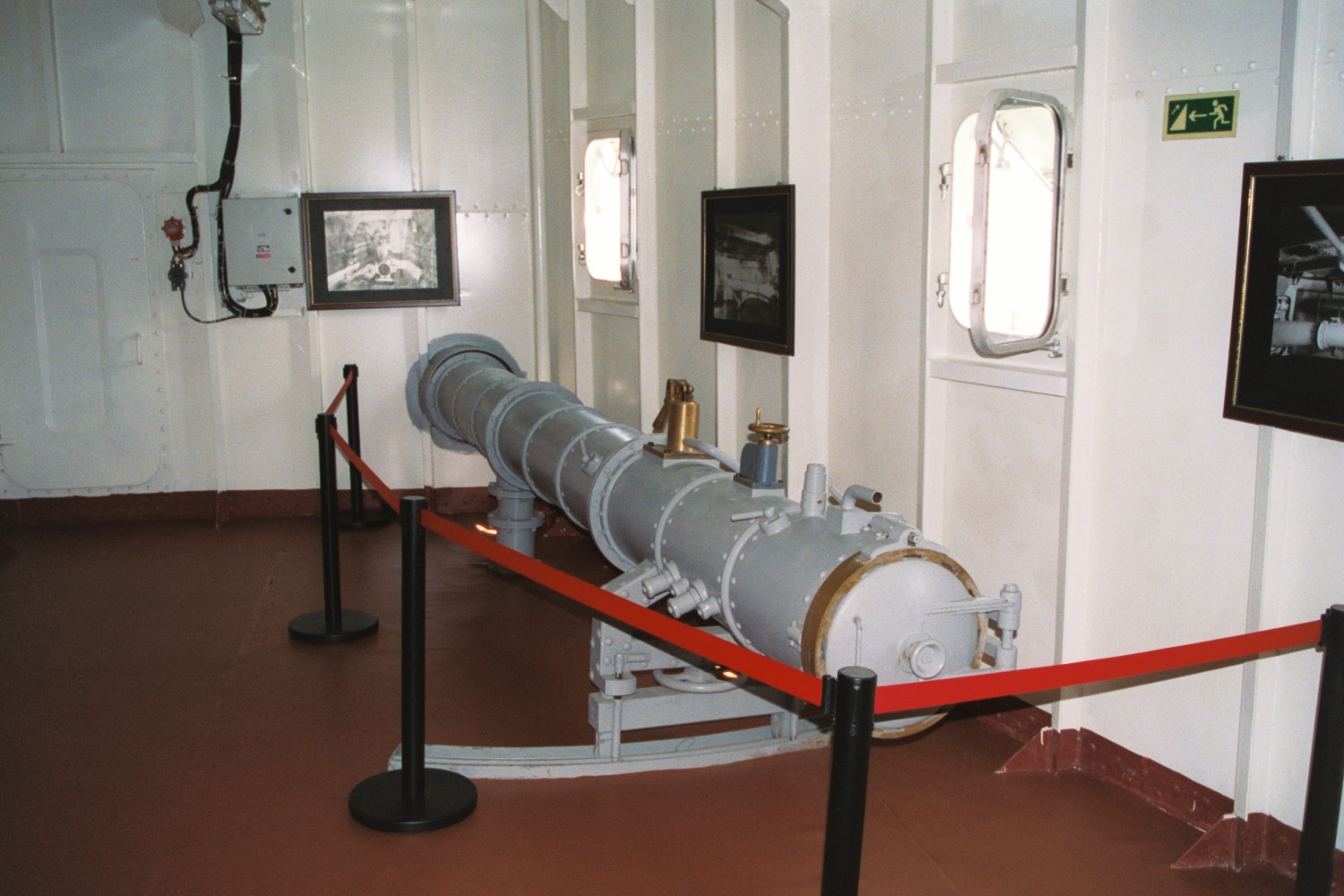 |
|
The trainable torpedo
tube |
Overall
I was very impressed with the Ting Yuen.
Clearly a lot of attention has gone into recreating her and a very
good job has been done. The
staff are all friendly and helpful and seem to take a real pride in their
endeavour. As you wander around
her it is easy to feel you are treading in Admiral Ting’s footsteps even
though this Ting Yuen is a creation of the 21st century, not the 19th.
She is a fine experience and if, like me, you can find functional
beauty in these war machines, a fine sight.
This sight can best be savoured from some little dai pai dongs just
across the bay where you can sit with some fresh seafood and a bottle of Yan
Tai beer, and gaze on the world’s newest pre-dreadnought battleship.
|
 |
|
The view from the dai
pai dongs |
go
to Part II
or
back to
other
periods or back
to expeditions
|